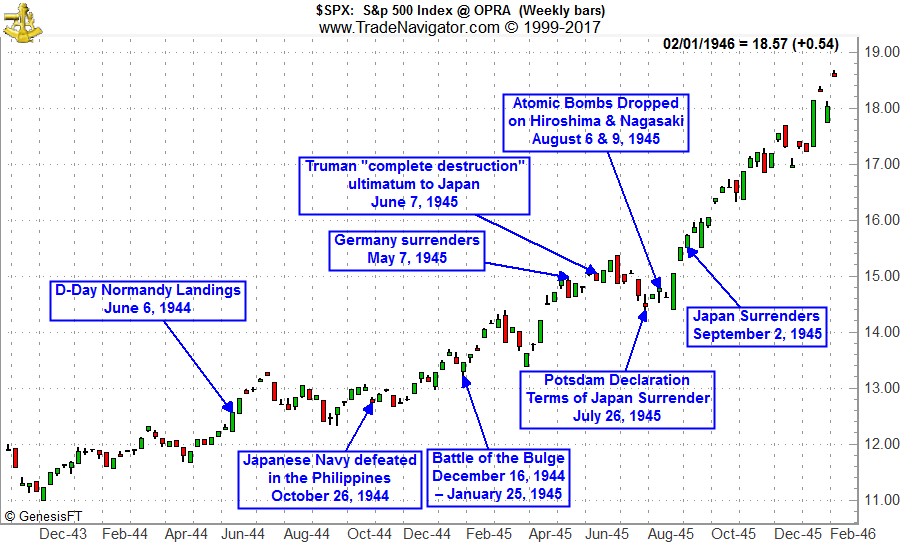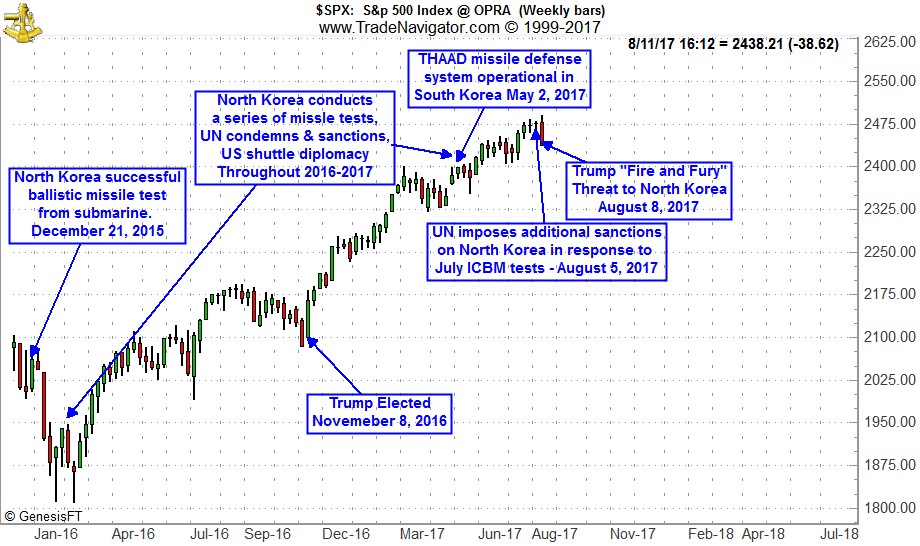As the market appears to be succumbing to the negative news flow and sits on the brink of a steeper decline we hope you have been heeding our warnings of the market’s increased vulnerability to this sort of thing during this perennially weak period of the year from August to October. The major averages are only off about 2-3% since their recent respective all-time highs, but most of that came today, so there is time to protect your portfolio with further defensive maneuvers if need be.
There’s been a lot of chatter comparing Trump’s “Fire and Fury” threat to North Korea with Truman’s Ultimatum to Japan on June 7, 1945 and the subsequent Potsdam Declaration defining the terms of Japan’s surrender. JFK’s battle of words and strategy with Khrushchev during the Cold War revolving around the Cuban Missile Crisis and the Berlin Wall have not been discussed as much recently, but are of similar ilk.
So we put together a few charts with facts and events plotted out against the S&P 500 to see what this latest standoff with North Korea could mean for stocks. Today’s selloff suggests the market is starting to take this current foreign policy conundrum more seriously.
In the case of Truman and Japan, the world had been at war for several grueling years and the market was rising steadily for three years from the 1942 low by the time Truman warned Japan in June of 1945. When JFK came in the market had bottomed just before he won the election in October 1960 and was rallying on his election.
The murkiness of Cold War machinations and the convoluted chain of events let the market rally until late 1961 to early 1962 until the impact of the newly erected Berlin Wall and U.S. missile installations in Italy and Turkey pissed the Soviets off that they put their own missile installations in Cuba. And as JFK and Khrushchev played real life Stratego the market fell apart.
People forget that North and South Korea are still at war and have been since the 1950s. They have been living with a cease fire and the protective DMZ ever since. Precisely how big of a threat does North Korea actually present to the U.S. and its allies is a difficult question to answer. But if this goes on it seems like it would play out more like the Cuban Missile Crisis, since we are currently not at war and the market has been on a tear under a new president who won in a tight race like JFK.



The market’s response today, DJIA down 0.93%, S&P 500 off 1.45% and NASDAQ shedding 2.13% does not appear to confirm North Korea as a major, significant or imminent threat. Today’s declines are not even the worst day of the year, May 17th was the worst. Perhaps the real reason why the market has avoided “panic selling” is because the U.S. most likely has more than sufficient missile defense capabilities in place. Yes, we can be concerned that these systems have not actually shot down a missile launched by North Korea, but they have had many successful tests.
Just searching “ballistic missile defense” on the web turns up a wide array of platforms and systems readily available. The U.S. has land based systems and sea-based capabilities. Terminal High Altitude Area Defense (THAAD) missile defense system is a land based system. The older Patriot system (recall Gulf War I) also has land-based anti-ballistic missile capabilities. Our sea-based system is called Aegis Ballistic Missile Defense System (ABMD) and it is deployed on at least five Ticonderoga class cruisers and twenty-five Arleigh Burke class destroyers. It is probably safe to assume that at least one or two of these Navy assets are not that far from North Korea.
We could debate the known and tested capabilities of these missile defense systems along with their potential effectiveness, but as a U.S. Navy veteran, Chris is also confident that their full capabilities are most likely not fully in the public domain. If and when the time comes and they are called upon to neutralize an incoming threat, they will most likely succeed. To even get to the point where our missile defense systems are called upon, a lot must go technically perfect for North Korea as well and this is something they have yet to repeatedly demonstrate.
Our Tactical Seasonal Switching Strategy currently has the Almanac Investor Stock and ETF Portfolios in a defensive posture with a mixture of long, short and defensive positions along with some cash. Well-chosen defensive positions in healthcare, utilities and bonds have ensured the portfolios have not fallen meaningfully behind the major indexes during their grind modestly higher over the past few months while still being well-aligned to survive any further weakness lurking ahead. History may not repeat itself exactly, but there sure are numerous similarities throughout. Our Seasonal MACD Buy Signal will confirm when it is safe to be more aggressive sometime after October 1.